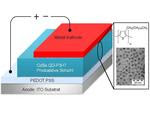
Scientists from the Institute for Microsystem Technology (IMTEK) and the Freiburg Materials Research Center (FMF), University of Freiburg has managed to develop a method for treating the surface of nanoparticles, which significantly increases the
efficiency of organic solar cells. Through the use of so-called quantum dots made of cadmium selenide could produce the scientists and researchers the highest-ever efficiency of 2 percent in hybrid solar cells by measurements of the FMF settled Working Group "Dye and Organic Solar Cells" at Fraunhofer Institute for Solar energy systems has been confirmed. Previous values were 1 to 1.8 percent. For hybrid solar cells have the photoactive layer of a mixture of inorganic nanoparticles and an (organic) polymer. The developed method is applicable in principle to many nanoparticles and opens up further opportunities for increasing efficiency of this type of solar cell. The process was patented and the results were published in a recent issue of the prestigious journal of applied physics, "Applied Physics Letters".
Organic solar cells belong to the so-called third generation of solar cells and are still in research stage. The world record for purely organic solar cells, which are both components of the
photoactive layer of organic materials, is currently at 7 percent for wet chemically produced films. In contrast to conventional silicon solar cells, which are mainly used for large-scale power generation, they have many advantages: they are much thinner and more flexible. The key advantage is its low cost and fast production. Therefore, they are better suited for integration into applications and systems in our everyday life with a limited duration, such as sensors or electronic devices in order to operate them energy self-sufficient. The use of batteries and wires could thus be drastically reduced in the future.
The team of researchers, chemists, physicists and engineers of the IMTEK and FMF closely together. "The interdisciplinary nature of the research group was an absolute godsend and has led to rapid progress in the project. So we could afford the synthesis of nanoparticles by modifying their surface and integration into composite materials, all from one source," says Group leader Dr. Michael Kruger. His group "Nanosciences" is part of the Chair for Sensors by Prof. Dr. Gerald Urban IMTEK. Based on the published results of his team is working - even in the framework of a Federal Ministry for Education and Research funded joint project - working to expand the proven method to other promising materials systems and thus to go on their way to market one step further. Preconditions are significantly more efficient than before, further increasing the durability of the materials and the reduction of manufacturing costs.
The project "Quantum Dot Polymer Hybrids as photoactive material in solar cells," is funded by the IMTEK Graduiertenkolleg "Micro Energy Harvesting" by the German Research Society.